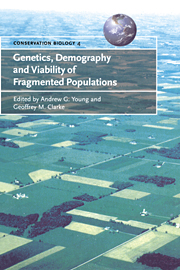Preface
Published online by Cambridge University Press: 29 January 2010
Summary
Since the publication of Soulé & Wilcox's Conservation biology: an evolutionary–ecological perspective in 1980, there has been a steady string of multiauthored works on conservation biology, most notably the other two Soulé books, Conservation biology: the science of scarcity and diversity (1986) and Viable populations for conservation (1987) and Schonewald-Cox et al.'s Genetics and conservation: a reference for managing wild animal and plant populations (1983). In addition, there has been a recent surge in the number of conservation biology textbooks available for both undergraduate and postgraduate teaching.
So we might ask ourselves, is there a need for another work in an already overcrowded field, and what makes this volume different from all the others. Many of the earlier works were written at the time that conservation biology was in the process of defining itself and finding its feet as a rigorous scientific discipline. As a result, and as could be expected, many of the individual contributions to these works were written from the perspective of the individual authors' traditional backgrounds in ecology, genetics and resource management and adapted to suit the growing concern of species decline. In addition, the works were very broad in coverage reflecting the very broad scope of conservation biology, ranging from biodiversity loss on large scales through deforestation to impacts on individual species and populations. These works made an invaluable contribution to promoting both an awareness and acceptance of conservation issues both within academia and land-use management agencies and laid the groundwork for much of modern conservation biology as a science.
- Type
- Chapter
- Information
- Genetics, Demography and Viability of Fragmented Populations , pp. xvii - xviiiPublisher: Cambridge University PressPrint publication year: 2000

